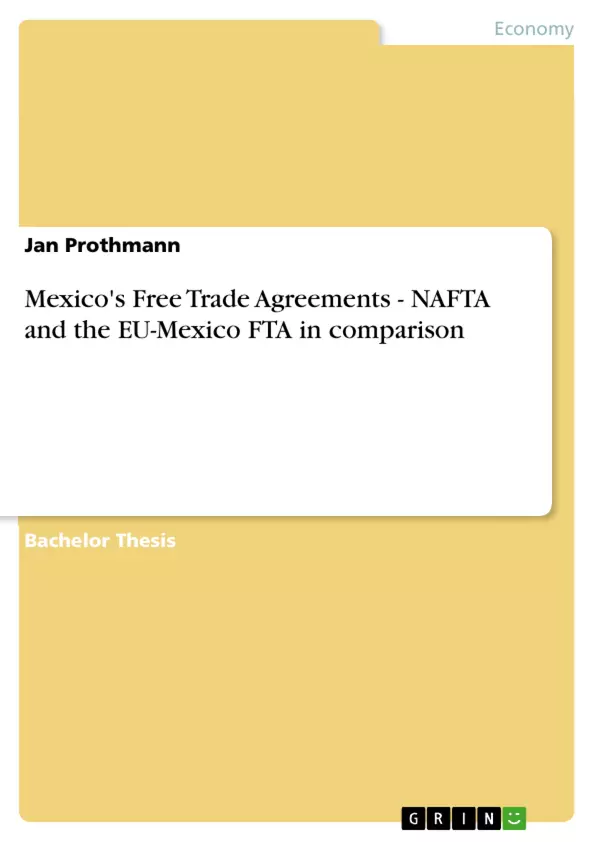Mexico has concluded various free trade agreements over the last decade, with NAFTA and the EU-Mexico FTA being the most important ones. In this paper, the effect of both agreements on bilateral trade is presented through descriptive statistics on the one hand, and by applying a time series analysis in the form of an export and import demand function on the other. The results of the graphical analysis indicate that the coming into force of NAFTA has led to a rise in Mexico’s trade with that bloc, even though the econometric analysis does not support the assertion that the conclusion of the agreement is responsible for that.
The EU-Mexico FTA has not led to a significant rise in Mexico’s exports to the EU, mainly due to transport costs. These costs are also the dominant factor in explaining exports from Mexico to its NAFTA partners, and therefore lead to the conclusion that the change in transport costs over time is more important than tariff reductions granted by the parties. Interestingly, Mexico’s imports from these two blocs are mainly determined by Mexico’s GDP and the exchange rate, rather than by transport costs.
Table of Contents
- Introduction
- Previous Research
- Contents of both Agreements
- NAFTA
- The EU-Mexico FTA
- Theoretical Framework of FTAs
- Static Analysis
- Dynamic Analysis
- Political Economy
- Development of Trade
- Trade over GDP and Trade Shares
- Commodity Groups
- Summary
- Econometric Analysis
- Methodology: Time Series Econometrics
- The Model
- Regression Results - Export Demand Function
- Regression Results - Import Demand Function
- Conclusion
Objectives and Key Themes
This thesis aims to compare the impact of NAFTA and the EU-Mexico FTA on bilateral trade between Mexico and its respective partners. It examines the reasons behind the different trade flow effects and analyzes the determinants of bilateral trade, including factors like transport costs and tariff reductions. The study also explores the significance of preferential regional trade agreements for Mexico, considering its economic development strategy and its role in global markets.
- The impact of NAFTA and the EU-Mexico FTA on bilateral trade between Mexico and its trading partners
- The determinants of bilateral trade between Mexico and its FTA partners, including transport costs and tariff reductions
- The significance of preferential regional trade agreements for Mexico's economic development
- The evolution of Mexico's trade policies and its shift towards an export-led economy
- The role of transport costs in shaping trade flows and influencing the effectiveness of free trade agreements
Chapter Summaries
- Introduction: This chapter provides an overview of the study's purpose and scope, highlighting the significance of free trade agreements for Mexico. It emphasizes the importance of NAFTA and the EU-Mexico FTA for Mexico's economic development and trade expansion.
- Previous Research: This section reviews existing research on the subject, highlighting previous studies that have examined the impact of free trade agreements on trade flows, particularly between Mexico and its partners. It explores the existing literature on the economic impact of NAFTA and the EU-Mexico FTA.
- Contents of both Agreements: This chapter outlines the key provisions of NAFTA and the EU-Mexico FTA, focusing on their respective trade liberalization measures, tariff reductions, and other relevant aspects. It highlights the specific conditions and terms of the agreements, emphasizing their potential impact on trade.
- Theoretical Framework of FTAs: This chapter delves into the theoretical underpinnings of free trade agreements, analyzing the rationale behind their creation and potential benefits for participating countries. It discusses static and dynamic effects of FTAs, exploring the potential for economic gains through increased trade and specialization.
- Development of Trade: This section examines the historical development of trade between Mexico and its FTA partners, analyzing trends in trade volumes, commodity composition, and other relevant indicators. It provides an overview of the actual trade flows between Mexico and its trading partners, including the role of FTA agreements in shaping these trends.
- Econometric Analysis: This chapter presents the results of an econometric analysis that investigates the impact of the two FTAs on bilateral trade. It utilizes time series econometrics to analyze export and import demand functions, providing evidence for the potential effects of the agreements on trade flows.
Keywords
The main keywords and focus topics of this thesis include free trade agreements (FTAs), NAFTA, EU-Mexico FTA, time series analysis, trade liberalization, export demand, import demand, transport costs, tariff reductions, and economic integration.
- Arbeit zitieren
- Jan Prothmann (Autor:in), 2005, Mexico's Free Trade Agreements - NAFTA and the EU-Mexico FTA in comparison, München, GRIN Verlag, https://www.grin.com/document/71615



